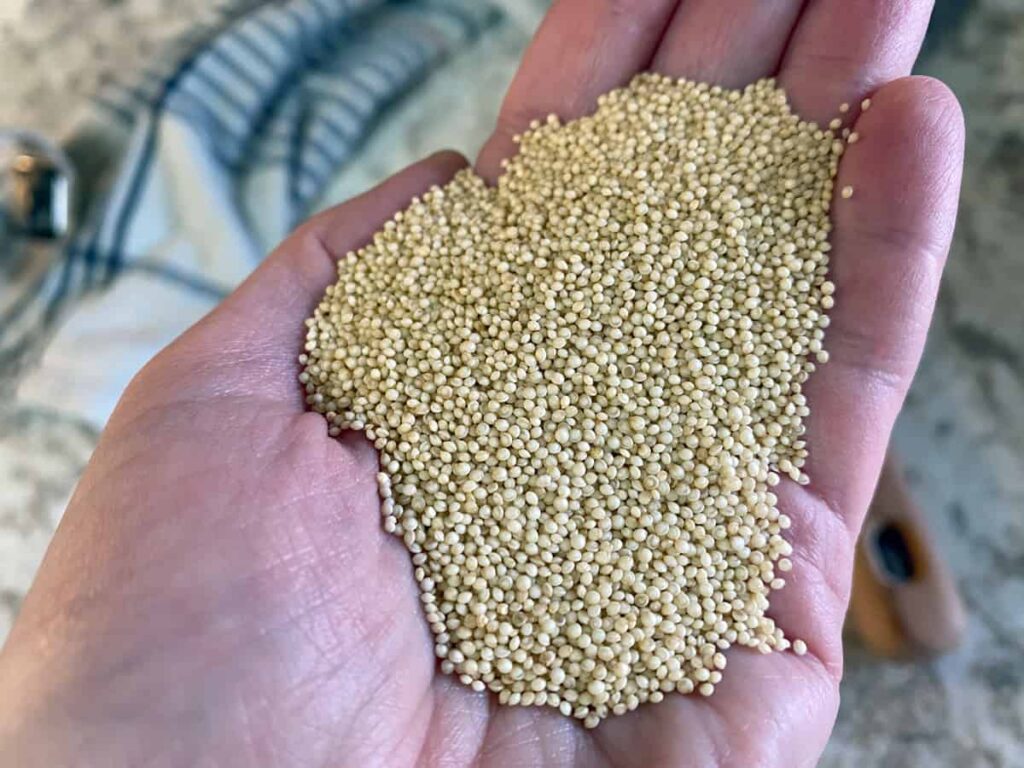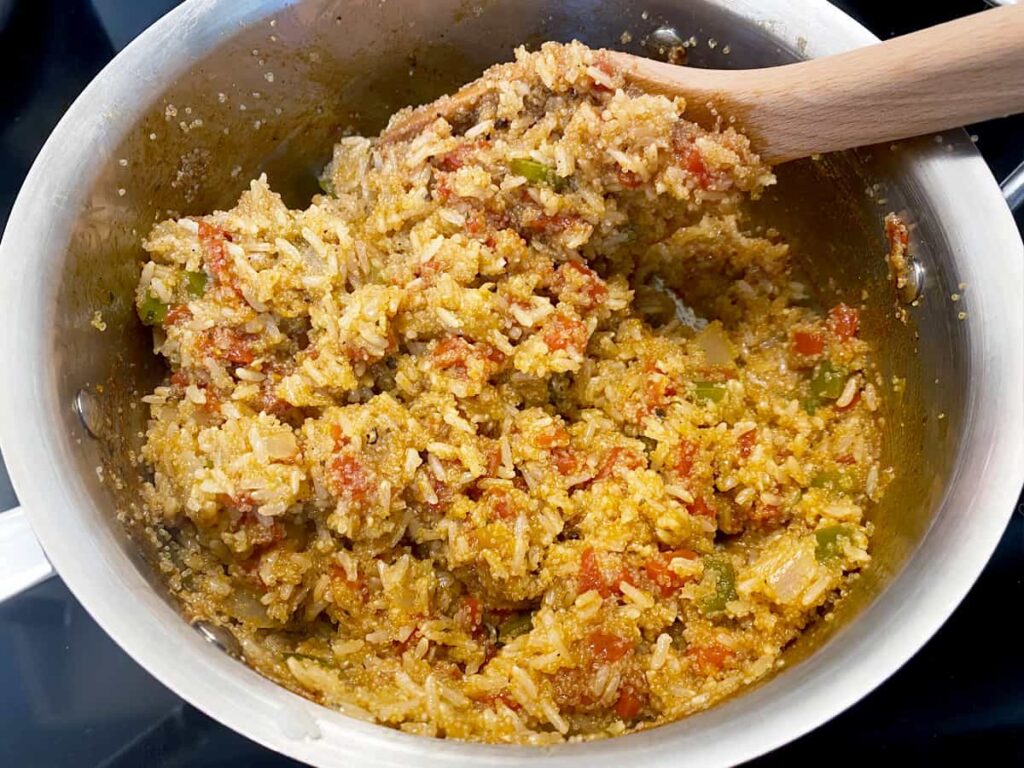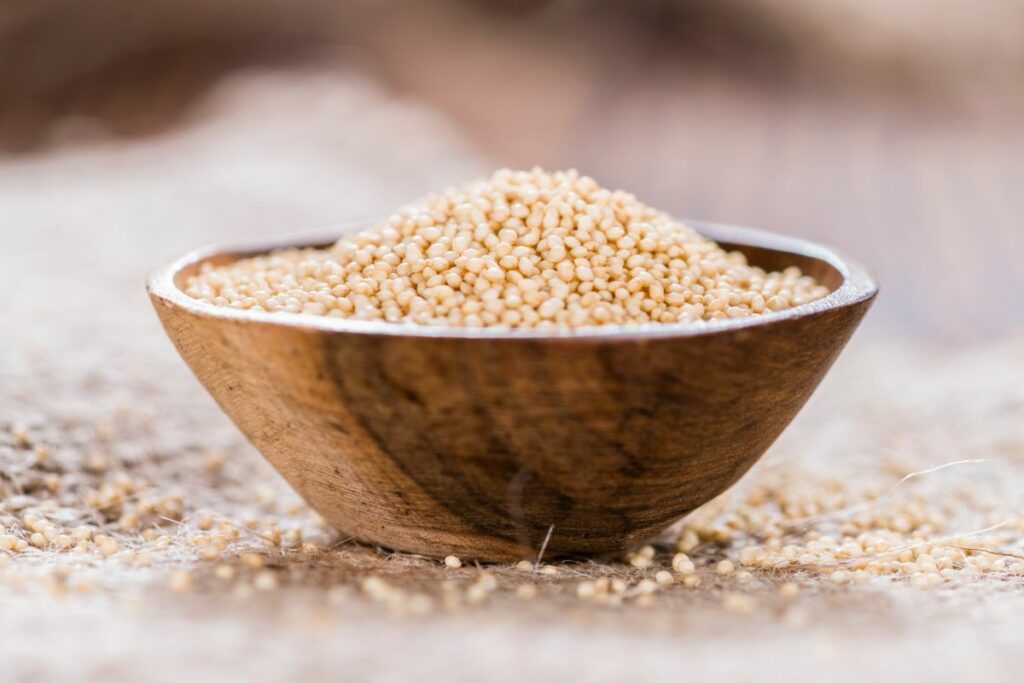Amaranth has always intrigued me as a versatile and delicious gluten-free seed, perfect for those looking to diversify their diet. Originating in Peru, this ancient grain-like seed has been a staple food for the Incas and Aztecs and is now enjoyed worldwide for its nutritious properties and culinary flexibility.
With its small, light tan-colored seeds, amaranth can be cooked similarly to rice and oats, making it a great addition to pilafs, porridges, and even gluten-free baking. Packed with essential minerals like calcium, magnesium, and iron, it’s hard to resist the benefits of incorporating amaranth into my meals. Not to mention the vibrant red, orange, and yellow shades of the flowers when the plant blooms – it’s truly a beautiful and wholesome food to explore!
In this guide, let me share some essential information on amaranth, from its rich history as “Inca Wheat” to the numerous ways it can be used to enhance flavors, textures, and nutrition in our daily meals. Because when you’ve got an incredible gluten-free seed like amaranth in your kitchen, the possibilities are endless!
Amaranth: A gluten-free alternative
When I discovered amaranth, I was thrilled to find a gluten-free alternative to common grains like wheat, barley, and rye. As a seed, amaranth is a pseudo-cereal, similar to quinoa, which means it packs a nutritional punch while being free of gluten. If you’re sensitive to gluten, you can add it to the many gluten-free options you should add to your pantry, like rice, oats, and buckwheat.
Amaranth is an ancient grain traceable to Peru, and it’s now available across the world. I find it amazing that this tiny seed has been a staple food in traditional cultures for so long. In places like India, Mexico, and Nepal, amaranth is even a key ingredient in their breakfast porridge.
One of the best parts about using amaranth as a gluten-free alternative is its versatility. I can easily substitute it for other grains in my recipes or add it to soups to give them a heartier texture. The high protein content in amaranth makes it a valuable addition to any meal, especially for those who prefer plant-based diets.
Not only is amaranth gluten-free, but it’s also loaded with essential nutrients. It’s high in several minerals, such as calcium, magnesium, and iron. In fact, amaranth contains more calcium than most other cereal grains, second only to teff. I love that amaranth provides antioxidants and anti-inflammatory properties that contribute to overall health.
Amaranth can be cooked in a variety of ways, from boiling it as a side dish to sprouting it for salads. Overall, its delightful nutty flavor and fluffy consistency make it a great addition to my gluten-free meal planning.
Health benefits and nutrition
Amaranth is an amazing gluten-free seed that has numerous health benefits. I’ve always been impressed by its rich nutritional profile. Here are some notable facts:
- It’s a complete protein, containing all nine essential amino acids. That’s pretty rare for a plant source!
- It’s packed with other nutrients like magnesium, fiber, lysine, iron, and more.
- Amaranth is an excellent source of fiber, which helps with maintaining healthy digestion and keeps me feeling fuller for longer. This makes it a great addition to weight management diets.
- It’s great for muscles and bones. The high lysine content is great for muscle mass and it plays a role in calcium absorption, promoting healthy bones.
- With a good amount of iron, it’s beneficial for people who need an extra boost in their iron intake.
- It offers a balanced mix of carbohydrates, calories, and vitamins, like vitamin B6, folate, and potassium.
- It has anti-inflammatory and antioxidant properties, consuming amaranth may have potential benefits in managing diabetes and stabilizing blood sugar levels.
Amaranth is a fantastic choice for anyone looking to diversify their diet with a nutrient-rich, gluten-free seed. It’s versatile, tasty, and the numerous health benefits it offers make it a great staple for maintaining overall wellness. I’m definitely a big fan of this super-seed!
Nutritional benefits
Amaranth is an ancient grain that has been gaining popularity due to its impressive nutritional profile. In a 100 g (or 3.5 oz) serving of Amaranth, you’ll find:
| Nutrient | Amount per 100g |
|---|---|
| Calories | 371 kcal |
| Protein | 13.6 g |
| Total Fat | 7.02 g |
| – Saturated Fat | 1.459 g |
| – Monounsaturated Fat | 1.685 g |
| – Polyunsaturated Fat | 2.778 g |
| Carbohydrates | 65.25 g |
| Dietary Fiber | 6.7 g |
| Sugars | 1.69 g |
| Vitamins & Minerals | |
| – Calcium | 159 mg |
| – Iron | 7.61 mg |
| – Magnesium | 248 mg |
| – Phosphorus | 557 mg |
| – Potassium | 508 mg |
| – Sodium | 4 mg |
| – Zinc | 2.87 mg |
| – Vitamin C | 4.2 mg |
| – Thiamin (B1) | 0.116 mg |
| – Riboflavin (B2) | 0.200 mg |
| – Niacin (B3) | 0.923 mg |
| – Vitamin B6 | 0.591 mg |
| – Folate (B9) | 82 μg |
| – Vitamin E | 1.19 mg |
| – Vitamin K | 2.3 μg |
Taste and cooking uses
When I first tried Amaranth, I noticed its unique taste which can be described as slightly nutty with a bit of mild sweetness to it. When toasted, the amaranth seeds release a fascinating aroma that enhances their flavor. One thing I love about amaranth is its versatility. It can be used in both savory and sweet dishes, making it a fantastic addition to my kitchen and diet.
- Cook it like rice or quinoa. To do this, simply combine one part amaranth seeds to two parts water and then bring to a boil. Reduce the heat to low, cover, and let it simmer for around 20 minutes until the water is absorbed. This results in a soft, fluffy texture that tastes great as a side dish or in a savory grain-based salad.
- Pop the seeds like popcorn. Amaranth seeds can be popped in a hot, dry skillet. The popped seeds have a delicate flavor, similar to popcorn, and can be eaten as a snack or used as crunchy toppings for dishes like yogurt or salads.
- Make it into bars or energy bites. To do this, I combine amaranth seeds with honey, peanut butter, or other binders and refrigerate the mixture to set. Then, I slice the mixture into bars or roll them into bites-sized balls. These portable snacks are not only delicious but also packed with nutrition, making them perfect for on-the-go.
- Mill gluten-free flour for baking. Its fine texture produces a moist and tender crumb in cakes, muffins, and other baked goods. Even though it has a distinct flavor, it does not overpower any other flavors in the baked treats.

Overall, I find amaranth to be a highly adaptable and dynamic food, with its nutty taste, enjoyable aroma, and wide array of cooking applications.
Amaranth in different forms
Amaranth is such a versatile seed that I’ve found numerous ways to incorporate it into my daily meals. As a gluten-free option, it has truly changed the way I cook and eat when having friends and family come over who are gluten-sensitive or have Celiac disease.
Some popular forms of amaranth and how to use them in your kitchen:
- Oil: Amaranth oil can be a great addition to your cooking arsenal. It has a unique flavor and makes for a healthier alternative to regular cooking oils. I particularly enjoy using it for salad dressings and light stir-fries.
- Flour: It adds an earthy flavor to bread, muffins, and other baked goodies. I find it particularly useful when combined with other gluten-free flours or starches for a more balanced texture.
- Porridge: Starting the day with a warm bowl of Amaranth porridge is delicious. Its high protein and fiber content keep me fueled and energized throughout the day.
- Soup: Use Amaranth to thicken your soups. Its starchy texture adds body and creaminess to any soup without the need for gluten or dairy.
- Salad: Make a hearty salad with whole grain Amaranth. It can keep your full longer and adds a lovely, nutty flavor to greens.
- Granola: Mixing Amaranth with oats, nuts, and seeds creates a delicious homemade granola. My kids can enjoy it as a snack or sprinkled over yogurt for extra crunch.
- Popped Amaranth: As I mentioned above, you can pop Amaranth like popcorn. It’s easy to prepare on the stovetop and makes for a fun, nutritious snack – perfect for movie nights at home.
Tips for preparing Amaranth
When I first tried Amaranth I was surprised at how little the “grains” are (they really are tiny seeds!). I was also surprised at how sticky it becomes as it cooks. Here are some lessons learned I want to share.
Cooking
When cooking amaranth, I usually follow a 1:2.5 ratio for seeds to water. This means for every cup of amaranth seeds, I bring 2.5 cups of water to a boil in a pot. After combining the seeds with boiling water, I reduce the heat, cover, and let it simmer for about 20 minutes until the grains are fluffy and water is absorbed.

Personally, I usually combine amaranth with rice (see my Mexican rice with Amaranth) because my kids can’t tell a texture difference.

Popping
I heat a dry pan on medium-high heat and add just enough amaranth to lightly cover the surface. I cover the pan and let the grains pop for about 30 seconds.
But just because you can pop it like popcorn, doesn’t mean that it is just like popcorn. Again, these seeds are super small so don’t feel obligated to eat it like pop corn. Think outside the box a bit as you can use popped Amaranth in dessert dishes and in making granola bars.
Milling
Milling Amaranth seeds to create flour is another way to use this pseudo-grain. Once milled, I can use amaranth flour for gluten-free baking recipes like bread, muffins, and pancakes.
In terms of storage, I always keep my amaranth seeds and flour in airtight containers in a cool, dark place. This helps maintain their freshness and extends their shelf life.
Sourcing
Sourcing Amaranth should be easy, as most health food stores and some supermarkets carry it. I was shocked to see it on the shelves of my local HEB, a Texas-based grocery store.
I have yet to see Amaranth flour on the shelves, but you can order it online.
Special tools
As for tools, a good-quality pot with a lid is essential for cooking amaranth. I also recommend a fine mesh sieve for rinsing the seeds before cooking, and a high-powered blender or spice grinder for milling.
Amaranth in international cuisine
My journey to explore Amaranth started with discovering its roots in Mexican food (my favorite!) where it was a staple in the ancient Aztec diet. Known as “huauhtli” in the Aztec language, amaranth was not only consumed for its nutritional benefits but also played a crucial role in their religious ceremonies. Today, Mexico continues to celebrate its rich history with Amaranth, creating delightful traditional dishes like “alegría,” a tasty snack made from Amaranth seeds mixed with honey or molasses.
Amaranth has also been a key ingredient in Peruvian cuisine. In the high-altitude Andean regions of Peru, this tiny, gluten-free seed is used to make a flavorful and filling porridge called “kiwicha,” which can be enjoyed either sweet or savory. More recently, it’s been used as an addition to salads, soups, and even bread.
Amaranth is also used in various regional dishes in India. Known as “rajgira” or “ramdana” in Hindi, amaranth becomes the star ingredient in “laddoos,” a popular Indian sweet made by rolling amaranth seeds with jaggery or sugar, and sometimes mixed with nuts and seeds. In certain parts of India, amaranth flour is utilized to make flatbreads, or “rotis,” which serve as a delicious gluten-free alternative to traditional wheat rotis.
Frequently asked questions
What are some gluten-free Amaranth recipes?
I love experimenting with amaranth because it’s versatile and gluten-free. Some of my favorite recipes include amaranth porridge, which is a great breakfast option, and amaranth salad with fresh veggies and a tangy dressing. You can also use amaranth as a crunchy topping for gluten-free casseroles or mix it with other gluten-free grains to create a delicious pilaf.
How do you cook Amaranth seeds?
Cooking amaranth seeds is pretty simple. I usually use a 1:3 ratio of amaranth seeds to water. Bring the water and seeds to a boil, then reduce the heat to a simmer. Cook for 20-25 minutes or until the water has been absorbed and the seeds are tender. You can also toast the Amaranth seeds in a dry skillet before cooking, which gives them a nuttier flavor.
Is Amaranth flour suitable for those with Celiac Disease?
Yes, Amaranth flour is a great option for people with celiac disease since it is naturally gluten-free. However, make sure you’re purchasing Amaranth flour labeled as gluten-free to avoid any potential cross-contamination with gluten-containing grains.
Can you make gluten-free bread with Amaranth flour?
Definitely! Amaranth flour can be used to make gluten-free breads, either on its own or mixed with other gluten-free flours for a more balanced texture. I like to experiment with various ratios of amaranth and other gluten-free flours to find my ideal combination for fluffy and delicious gluten-free bread.
Is Amaranth lectin-free?
No, amaranth does contain lectins, but the amount is lower than many other grains and seeds. I find that cooking Amaranth properly and combining it with a variety of other foods helps to minimize any potential lectin-related issues.
Which is better: Amaranth or Quinoa?
Both amaranth and quinoa are great gluten-free options, and I don’t think one is necessarily better than the other. They’re both nutrient-dense and offer a range of health benefits. Amaranth is known for its high protein content and being rich in lysine, while quinoa is often praised for its balanced amino acid profile. I enjoy using both in my gluten-free cooking, as they bring different textures and flavors to the table.








